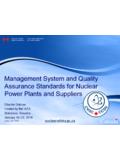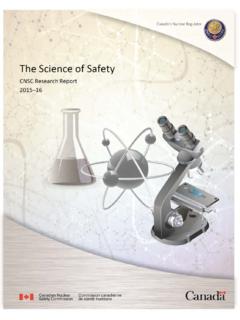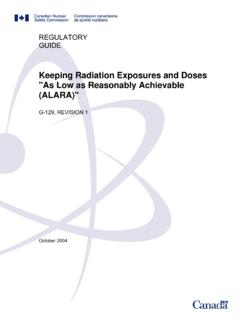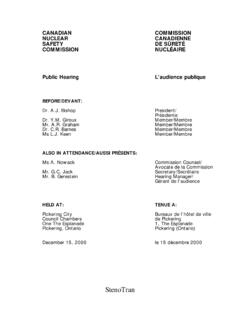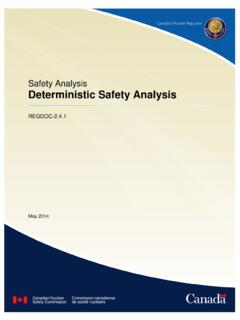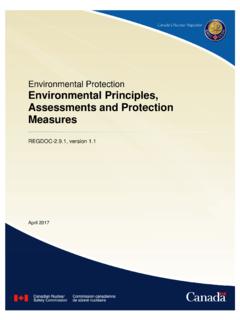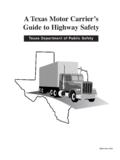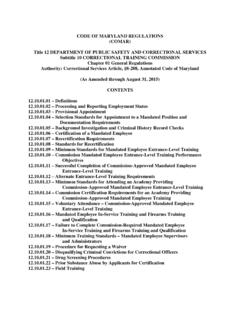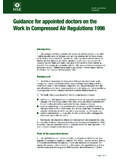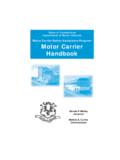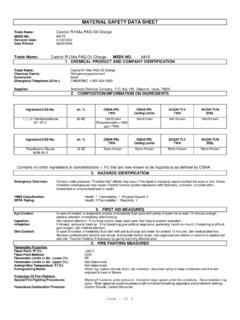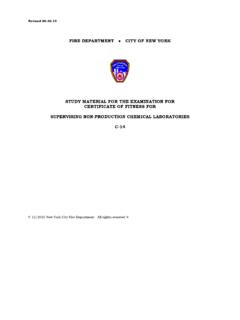Transcription of REGDOC-2.6.3, Fitness for Service: Aging …
1 Fitness for Service Aging Management March 2014 Fitness for Service: Aging Management Regulatory Document Canadian Nuclear safety Commission (CNSC) 2014 PWGSC catalogue number CC172-104/2014E-PDF ISBN 978-1-100-23345-1 Extracts from this document may be reproduced for individual use without permission provided the source is fully acknowledged. However, reproduction in whole or in part for purposes of resale or redistribution requires prior written permission from the Canadian Nuclear safety Commission. galement publi en fran ais sous le titre : Aptitude fonctionnelle : Gestion du vieillissement Document availability This document can be viewed on the CNSC website at To request a copy of the document in English or French, please contact: Canadian Nuclear safety Commission 280 Slater Street Box 1046, Station B Ottawa, Ontario K1P 5S9 CANADA Tel.
2 : 613-995-5894 or 1-800-668-5284 (in Canada only) Facsimile: 613-995-5086 Email: Website: Facebook: YouTube: Publishing history March 2014 Version March 2014 , Aging Management Preface This regulatory document is part of the CNSC s Fitness for Service series of regulatory documents, which also covers reliability and maintenance programs for power reactor facilities. The full list of regulatory document series is included at the end of this document and can also be found on the CNSC s website at , Aging Management, sets out the requirements of the CNSC for managing Aging of structures, systems and components (SSCs) of a power reactor facility. It also provides guidance as to how these requirements may be met. This document replaces RD-334, Aging Management for Nuclear Power Plants, which was published in June 2011.
3 Aging management is the set of engineering, operational, inspection and maintenance actions that control, within acceptable limits, the effects of physical Aging and obsolescence of SSCs that occur over time or with use. An Aging management program or plan is a set of policies, processes, procedures, arrangements and activities for managing the Aging of SSCs of a reactor facility. Effective Aging management ensures that required safety functions are reliable and available throughout the service life of the facility, in accordance with the licensing basis. This document is intended to form part of the licensing basis for a regulated facility or activity. It is intended for inclusion in licences as either part of the conditions and safety and control measures in a licence, or as part of the safety and control measures to be described in a licence application and the documents needed to support that application.
4 Important note: Where referenced in a licence either directly or indirectly (such as through licensee-referenced documents), this document is part of the licensing basis for a regulated facility or activity. The licensing basis sets the boundary conditions for acceptable performance at a regulated facility or activity and establishes the basis for the CNSC s compliance program for that regulated facility or activity. Where this document is part of the licensing basis, the word shall is used to express a requirement to be satisfied by the licensee or licence applicant. Should is used to express guidance or that which is advised. May is used to express an option or that which is advised or permissible within the limits of this regulatory document. Can is used to express possibility or capability.
5 Nothing contained in this document is to be construed as relieving any licensee from any other pertinent requirements. It is the licensee s responsibility to identify and comply with all applicable regulations and licence conditions. i March 2014 , Aging Management Table of Contents 1. Introduction ..1 1 Scope .. 1 Relevant legislation .. 1 International standards .. 2 2. General Concepts ..3 Aging and obsolescence of structures, systems and components .. 3 Systematic and integrated approach to Aging management .. 4 3. Proactive Strategy for Aging Management ..6 Design .. 7 Fabrication, construction, and installation .. 9 Commissioning .. 9 Operation .. 10 Decommissioning .. 13 4. Integrated Aging Management ..13 Organizational arrangements for effective Aging management.
6 14 Data collection and record-keeping system to support Aging management .. 14 Screening and selection of structures, systems and components .. 15 Evaluations for Aging management .. 16 Condition assessments .. 19 SSC-specific Aging management plans .. 19 Management of obsolescence .. 20 Interfaces with other supporting programs .. 21 Implementation of Aging management 21 Review and improvement .. 22 Appendix A: Attributes of an Effective Aging Management Plan ..23 Appendix B: Sample Methodology for Aging Evaluation ..24 March 2014 , Aging Management Glossary ..25 References ..29 Additional Information ..30 March 2014 , Aging Management Aging Management 1. Introduction Purpose , Aging Management, sets out the requirements of the CNSC for managing the Aging of structures, systems and components (SSCs) of a power reactor facility.
7 Guidance is also provided as to how these requirements may be met. Managing the Aging of a reactor facility means to ensure the availability of required safety functions throughout the facility s service life, with consideration given to changes that occur over time and with use. This requires addressing both physical Aging and obsolescence of SSCs where this can, directly or indirectly, have an adverse effect on the safe operation of the reactor facility. This document is intended for use by licensees and applicants in establishing, implementing and improving Aging management (AM) programs and plans for reactor facilities. Scope Aging Management sets requirements to provide assurance that Aging management is appropriately and proactively considered in the different phases of a reactor facility s lifecycle.
8 The lifecycle phases can apply to individual SSCs as well as the entire reactor facility. Specific requirements are also provided for establishment, implementation and improvement of AM programs and plans through application of a systematic and integrated approach. This document provides a framework within which codes and standards can be applied to provide assurance that physical Aging and obsolescence of SSCs are effectively managed. Where appropriate, this document may be applied to other nuclear facilities, with due consideration of the differences compared to those of a power reactor facility in hazard potential and complexity of affected systems. Relevant legislation The following provisions of the Nuclear safety and Control Act (NSCA) and the regulations made under it are relevant to this document.
9 Subsection 24(4) of the NSCA states that No licence shall be issued, renewed, amended or replaced and no authorization to transfer one given - unless, in the opinion of the Commission, the applicant or, in the case of an application for an authorization to transfer the licence, the transferee (a) is qualified to carry on the activity that the licence will authorize the licensee to carry on, and (b) will, in carrying on that activity, make adequate provision for the protection of the environment, the health and safety of persons and the maintenance of national security and measures required to implement international obligations to which Canada has agreed 1 March 2014 , Aging Management Paragraph 3(1)(k) of the General Nuclear safety and Control Regulations states that an application for a licence shall contain the following information.
10 (k) the applicant s organizational management structure insofar as it may bear on the applicant s compliance with the Act and the regulations made under the Act, including the internal allocation of functions, responsibilities and authority Paragraphs 12(1)(c) and (f) of the General Nuclear safety and Control Regulations state that every licensee shall (c) take all reasonable precautions to protect the environment and the health and safety of persons and to maintain security of nuclear facilities and nuclear substances; and (f) take all reasonable precautions to control the release of radioactive nuclear substances or hazardous substances within the site of the licensed activity and into the environment as a result of the licensed activity Paragraphs 6(d), (m), and (n) of the Class I Nuclear Facilities Regulations state that an application for a licence to operate a Class I nuclear facility shall contain , in addition to other information: (d) the proposed measures, policies, methods and procedures for operating and maintaining the nuclear facility; (m) the proposed responsibilities of and qualification requirements and training program for workers, including the procedures for the requalification of workers.

